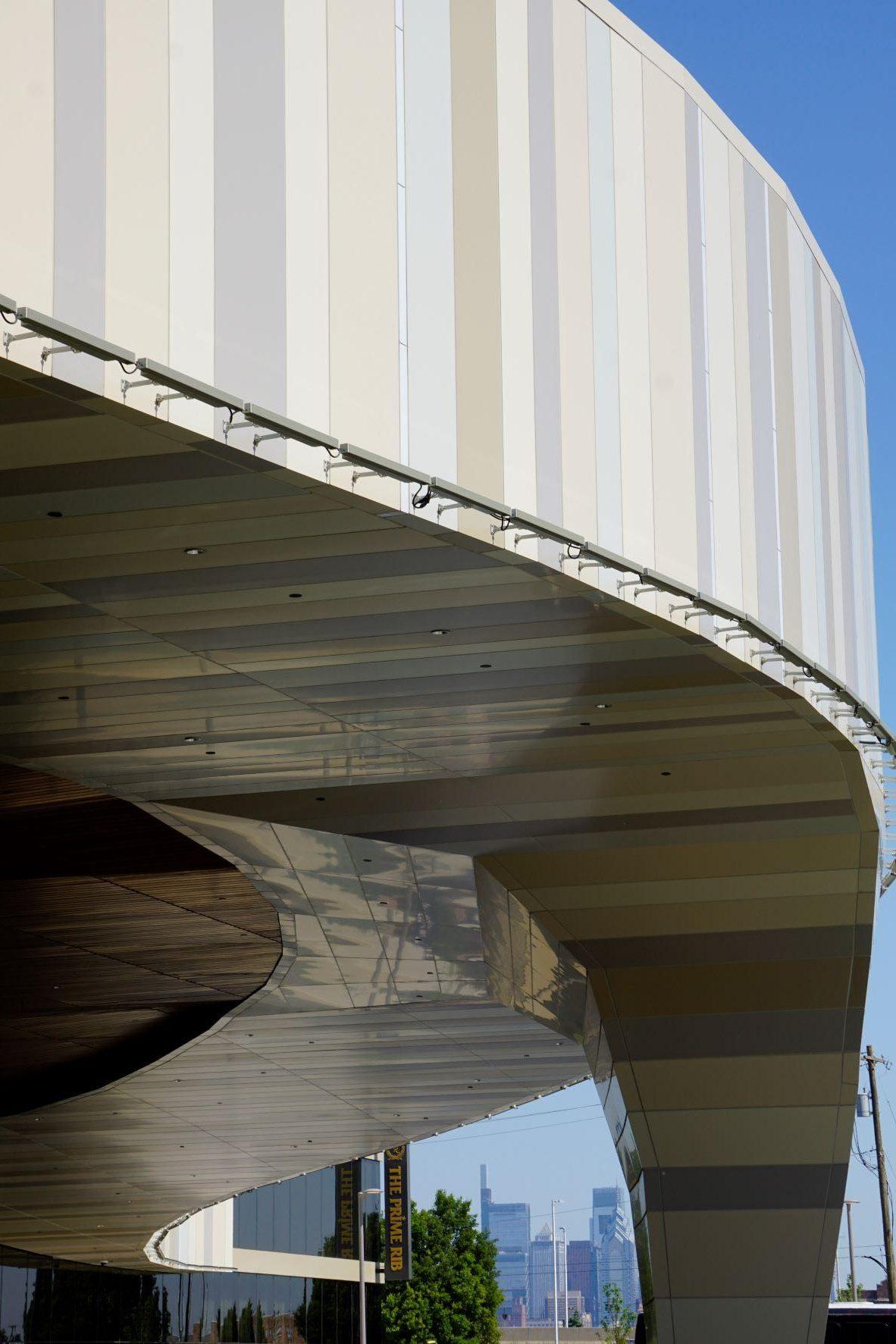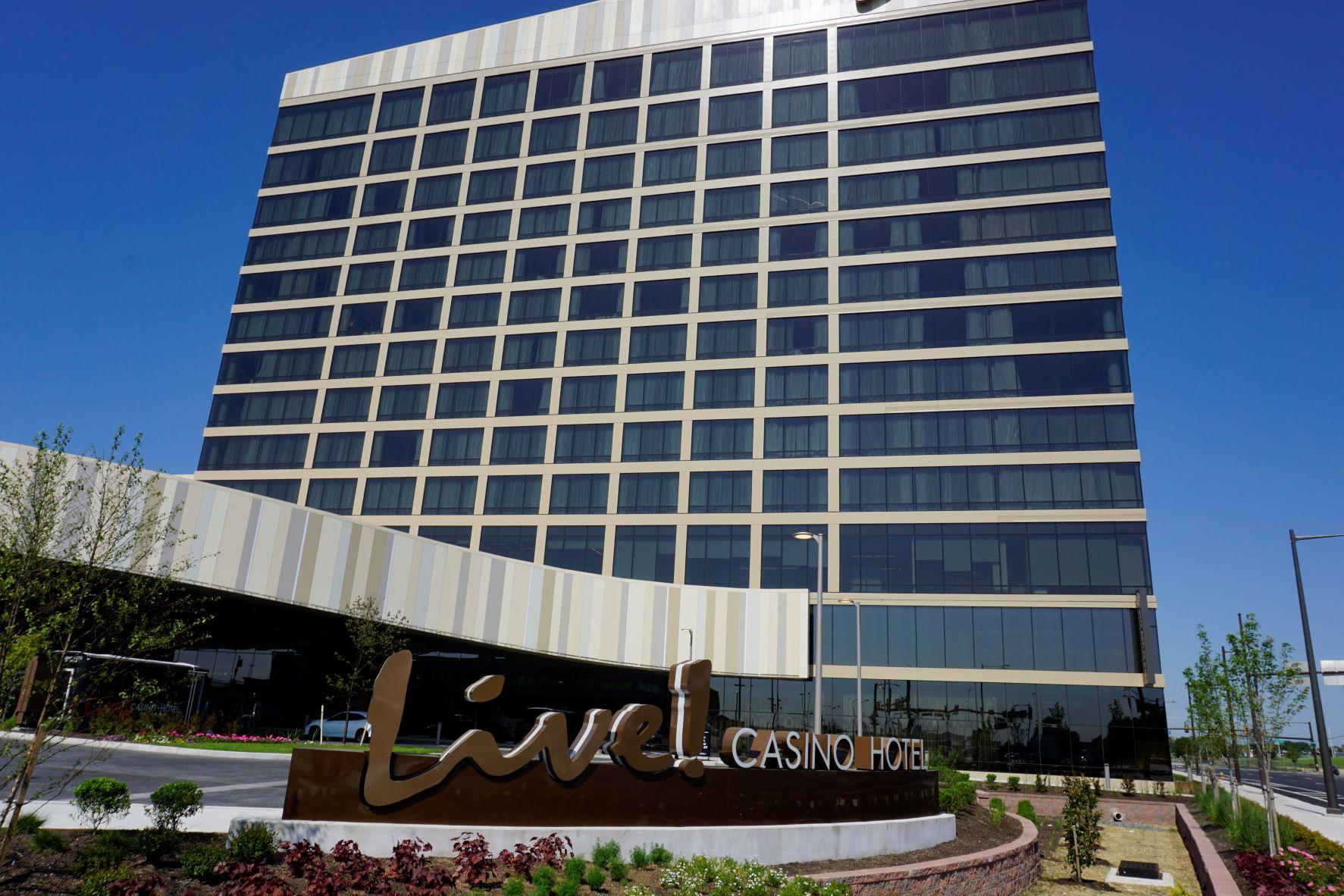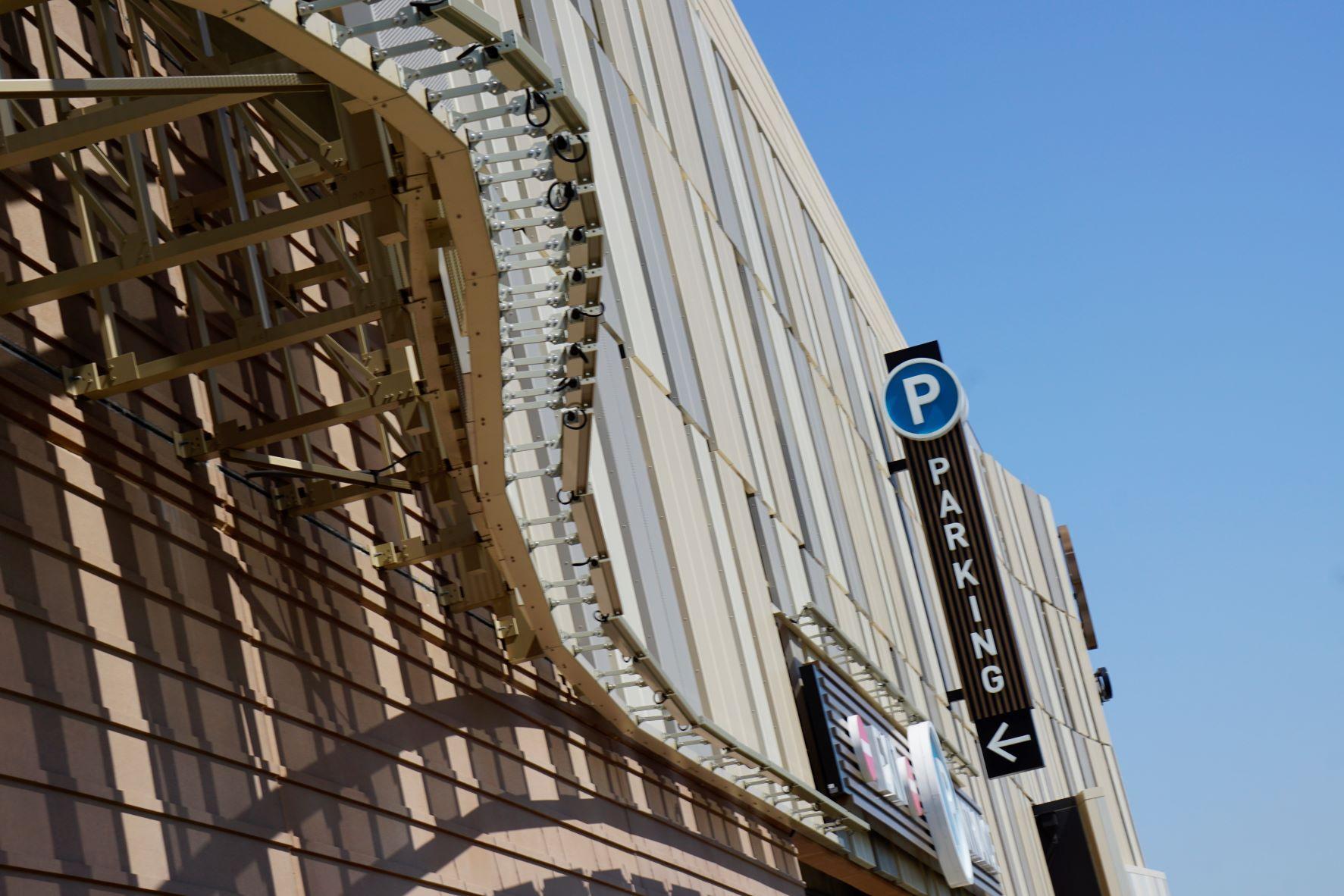Overview of Project
EDA was awarded the Live! Casino & Hotel bid in 2018 and was tasked with providing watertight elevations for the building and fabricating and installing over 90,000 square feet of panels. This project utilized over a dozen vendors, fabricators, and subcontractors and was anything but ordinary.
To learn more about this unique project, we spoke with EDA Superintendent Sean Timoney, Estimator Jeff Dorneman, and Business Development Representative Cory Robbins. In our conversations, we gained insight into how EDA used an innovative installation technique to meet the building owner’s vision and to deliver on a tight timeline. For Dorneman, “(the project) was outside the box, it took a different path than was expected…and it was a success.”
Scope of the Live! Casino & Hotel Project
In addition to the over 90,000 square feet of panels that needed to be fabricated, shipped, and installed on-site, the job also involved seven different colors of ACM panels and 12 different module makeups to assemble. On the roof, EDA was tasked with relocating cell towers that needed to remain on location. Further, after the work began, the owner changed the scope of the project to include large electric television screens that would protrude from the elevation. This addition was only possible because of the unique installation method that EDA used during this job. Dorneman reflects by saying, “(we) broke the project into three separate jobs…no project is too big if you break it down into smaller projects.”
“The project was made up of three parts: a casino floor, a twelve-story hotel, and a five-level parking garage. It combined the prefabrication back-up panels, ACM panels, there were areas in the back of the house above the roofline that included louvers, and we changed the ACM panels to single-skin corrugated metal panels. When we got to the parking garage it was a combination of ACM panels as well as perforated aluminum plate panels…which stand off the building several feet, and actually look like they are curved.”
- Jeff Dorneman | Estimator
In addition to the vast scope of the project, the schedule itself was extremely tight, as the Live! Casino gaming license had an expiration date that could not be moved. With extensive interior work that could not begin until after the building was dried-in, it was imperative that the building be dried-in as soon as possible.
“Their gaming license was going to expire on a certain date and they would have had to renew it which would have cost them a lot of money and likely put them out of the game. So the project completion date could not be moved. We told them that EDA could get their building dried-in 10-weeks earlier through a hybrid panelization delivery system, as opposed to traditional pre-fabrication.”
- Cory Robbins | Business Development
Challenge Using Traditional Panelization
Robbins explains how traditional panelization was not possible because “they were in such tight windows that if anything went wrong - the owner wanted to change the look, or the architect wanted to change the color of one or two panels - it would have put everything back several weeks. EDA’s idea to move away from pre-fabrication and utilize a different delivery system would allow us to be more agile, giving us more time to work on the aesthetics.” With this in mind, Dorneman came up with Hybrid Panelization, a new installation method that kept the building watertight and met the needs of the building owner.

“We were working with B.I.M. (Building Information Modeling). There would be a living model/blueprint online that all parties could edit at the same time. Essentially the architect would say we want it to look like this and then we would say that’s going to run into this pipe, or that’s going to run into this mechanical, or that HVAC. It was constantly being built as we went forward, because the lead-times were like 30-weeks, so we had that window to keep this project rolling.”
- Cory Robbins | Business Development
Overall, this project took a collective effort of everyone involved and it was a true example of being successful together. The biggest challenge in this project, was not only the large scope of the job, but the fact that large electric television screens were added after the design was initially finalized. According to Robbins, “it became a ‘design build’ project. Essentially the architect and the sub-contractor worked hand-in-hand as the drawings were being made and they let us give input throughout.” This “design-build” concept is rare in construction, because normally the architect draws it and the contractors build it. For the Live! Casino project however, EDA worked directly with the architects throughout the process to ensure that we were both considering the many variables at play. This allowed us to deliver the buildout to meet the needs of both the architect and general contractor.
That is where Hybrid Panelization comes in…
What is Hybrid Panelization?
Exterior elevations tend to be some of the most difficult parts of the construction process and are most at risk for litigation due to leaks. With traditional installation not an option, EDA came up with Hybrid Panelization. Hybrid Panelization, allowed the shop to create the wall chunks, studs, sheathing, and weather barriers, but they stopped short of a full prefabrication. Instead, they brought these pieces to the jobsite and assembled everything there. Caulk joints, which traditionally can lead to leaks within 3-10 years, were used in addition to waterproofing seam tape, to create a Monolithic Weather Barrier. This gave the wall two forms of waterproofing and assured it would hold up long-term.
“(Hybrid Panelization) allowed us to fly through the building to enclose it while coming along with the work at a rate that’s achievable where you wouldn’t be able to keep up under normal circumstances.”
- Sean Timoney | Superintendent
According to Robbins, the simplest way to describe Hybrid Panelization is, “building the studs, sheathing, AVB, and stopping. We then stick build the rest (sub-framing, insulation, and cladding get installed) in the field.” Once the build process was complete, EDA taped the seams to create the monolithic air-barrier, which allowed the interior building process to begin weeks earlier. It also accommodated for more last-minute changes to the exterior panels used on the building.

Why Hybrid Panelization?
There are a number of benefits to Hybrid Panelization, but the key is that the Monolithic Weather Barrier created with this process makes a better seal. With Hybrid Panelization, the interior of the building is dried-in and ready for installation months earlier than the traditional process. In fact, Robbins says that Hybrid Panelization is what made this specific project possible: “Without Hybrid Panelization, they never would have made that date. We were only building the panels up to the AVB which gave us more time to work on the aesthetics.”
“Doing the panel system the way we did it (Hybrid Panelization), allowed us to move very far along with the actual balloon framing and weather barrier while still spending time to get our actual ACM installation and everything associated with that going.”
- Sean Timoney | Superintendent
For the Live! Casino & Hotel Philadelphia project, Hybrid Panelization allowed the owner of the property to make exterior changes to the project that would not have been permitted in a traditional job. Things like the color of the panels and adding TVs to the exterior of the building were possible because of Hybrid Panelization. Additionally, EDA was able to leave an opening in the building for other crews to bring in HVAC materials and other supplies which would not have been possible if using traditional panelization. Hybrid Panelization gave significant flexibility and is a major reason that the final product looks the way it does.
Using Hybrid Panelization Moving Forward
The use of Hybrid Panelization at Live! Casino & Hotel Philadelphia was an innovative approach to paneling a unique job. We asked Dorneman if this approach to panel installation could be used again at future jobs. He responded saying, “The beauty of this Hybrid Panelization method is that it does have applications at other projects. It is not for every job, like if the building is too tall, if the schedule is too tight. With a low-rise building, it is absolutely a viable option for construction.”

Robbins also shared how he sees Hybrid Panelization being used moving forward saying, “we wish more owners were aware of this process because it can be highly competitive to traditional panelization. It gives building owners and architects more flexibility and our process is faster.”
EDA is already looking ahead to using Hybrid Panelization for a restoration project with the Philadelphia Housing Authority. In this project, Hybrid Panelization will be used to put the panels on first and then return at a later date to install the ACM panels. The concept of Hybrid Panelization will certainly be an asset to the EDA team and future clients. Hybrid Panelization highlights EDA’s commitment to innovation and doing the job right. It also will remain a tool that can be used to get buildings dried-in early and finished on-time.
